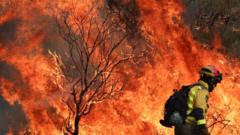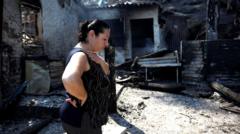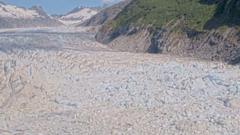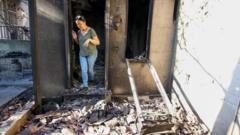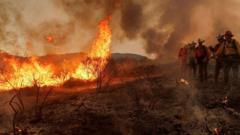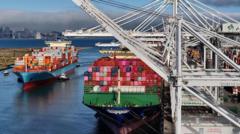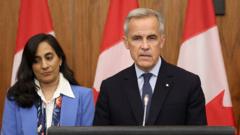The wildfire crisis in Canada has led to thousands of evacuations and ongoing threats as dry conditions fuel massive fires.
Canada’s Wildfire Season Intensifies: Thousands Evacuated Amidst Uncontrolled Blazes

Canada’s Wildfire Season Intensifies: Thousands Evacuated Amidst Uncontrolled Blazes
Communities in Eastern Canada are facing mandatory evacuations as wildfires rage on, marking this season as one of the worst in history.
With the summer drawing nearer to its end, thousands of citizens across Eastern Canada are being forced to evacuate their homes as a severe wildfire season shows no signs of abating. The wildfires, considered some of the most devastating in the nation’s history, have led to mandatory evacuation orders in Newfoundland and Labrador, leaving communities in a precarious state.
According to the Canadian Interagency Forest Fire Center, there are currently over 700 active wildfires burning across the country. Already, 18.5 million acres of forestland have been scorched, making this wildfire season the second worst on record after 2023, when a staggering 31.3 million acres had burned by August. Awa Cissé, a representative from the center, cautioned that the ongoing fire season could well continue into the fall, prolonging the danger for affected areas.
While various regions in Canada are typically accustomed to wildfire seasons, this year has proven significantly more challenging due to the prolonged drought conditions and heat waves gripping the country. In Western Canada, provinces like Saskatchewan and Manitoba have reported some of the most severe wildfires, including the Shoe fire in Saskatchewan, which has burned for months and covers an area larger than Grand Canyon National Park.
Recent rainfall across Saskatchewan and Manitoba has provided some reprieve, helping to quell fires and reduce the risk of new outbreaks. However, attention has now shifted to the eastern provinces, particularly Newfoundland and Labrador, which are facing an unusual season of wildfires characterized by multiple out-of-control blazes.
In Newfoundland, the onset of fires in areas typically considered ‘wildfire-safe’ has raised significant concerns. The capital, St. John’s, is grappling with dry conditions that resemble those more commonly seen in Western Canada, prompting state of emergency declarations and heat warnings throughout the province. Premier John Hogan announced heightened restrictions on outdoor activities and warned citizens about potential penalties for non-compliance, underscoring the urgency of the situation.
Parallel concerns are emerging in Southern British Columbia, where recent forest fires are intensifying, particularly on Vancouver Island, amidst unusually dry weather conditions. Conversely, the province of Quebec has largely avoided wildfires this season, courtesy of wet weather patterns throughout the summer months.
As cities brace for the continued threats posed by wildfires with community safety as a priority, the importance of preparedness and caution resonates across the nation.
According to the Canadian Interagency Forest Fire Center, there are currently over 700 active wildfires burning across the country. Already, 18.5 million acres of forestland have been scorched, making this wildfire season the second worst on record after 2023, when a staggering 31.3 million acres had burned by August. Awa Cissé, a representative from the center, cautioned that the ongoing fire season could well continue into the fall, prolonging the danger for affected areas.
While various regions in Canada are typically accustomed to wildfire seasons, this year has proven significantly more challenging due to the prolonged drought conditions and heat waves gripping the country. In Western Canada, provinces like Saskatchewan and Manitoba have reported some of the most severe wildfires, including the Shoe fire in Saskatchewan, which has burned for months and covers an area larger than Grand Canyon National Park.
Recent rainfall across Saskatchewan and Manitoba has provided some reprieve, helping to quell fires and reduce the risk of new outbreaks. However, attention has now shifted to the eastern provinces, particularly Newfoundland and Labrador, which are facing an unusual season of wildfires characterized by multiple out-of-control blazes.
In Newfoundland, the onset of fires in areas typically considered ‘wildfire-safe’ has raised significant concerns. The capital, St. John’s, is grappling with dry conditions that resemble those more commonly seen in Western Canada, prompting state of emergency declarations and heat warnings throughout the province. Premier John Hogan announced heightened restrictions on outdoor activities and warned citizens about potential penalties for non-compliance, underscoring the urgency of the situation.
Parallel concerns are emerging in Southern British Columbia, where recent forest fires are intensifying, particularly on Vancouver Island, amidst unusually dry weather conditions. Conversely, the province of Quebec has largely avoided wildfires this season, courtesy of wet weather patterns throughout the summer months.
As cities brace for the continued threats posed by wildfires with community safety as a priority, the importance of preparedness and caution resonates across the nation.


